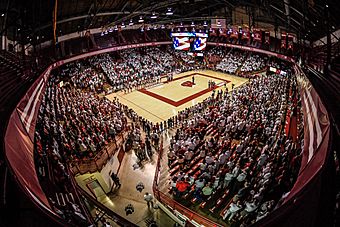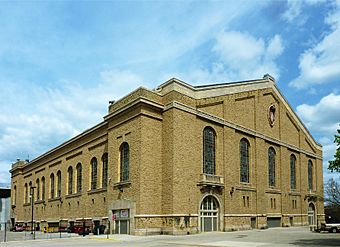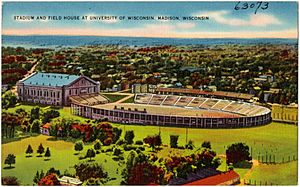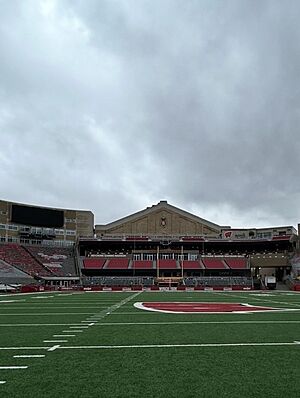Wisconsin Field House facts for kids
|
UW Field House
|
|

A volleyball match at the field house in 2017
|
|
| Location | 1450 Monroe St. Madison, WI 53711 |
|---|---|
| Public transit | |
| Owner | University of Wisconsin–Madison |
| Operator | University of Wisconsin–Madison |
| Capacity |
|
| Construction | |
| Broke ground | September 26, 1929 |
| Opened | December 13, 1930 |
| Construction cost | $434,000 |
| Architect | Arthur Peabody, Paul Cret, William Christenson |
| Tenants | |
|
|
|
University of Wisconsin Field House
|
|
 |
|
| Area | 2 acres (0.81 ha) |
| Architectural style | Italian Renaissance |
| NRHP reference No. | 98000829 |
| Added to NRHP | July 1, 1998 |
The Wisconsin Field House, also known as the UW Field House, is a large building at the University of Wisconsin–Madison. It's a place where many different events happen, especially sports. You can find it right next to Camp Randall Stadium.
Besides sports games, the Field House has hosted big school events like graduation ceremonies and concerts. It's a really important building, so it was added to the National Register of Historic Places in 1998. This means it's recognized as a special historical place in the United States.
Contents
The Story of the UW Field House
The University of Wisconsin started having team sports way back in the 1800s. In 1892, they built the Red Gym for indoor games. A year later, in 1893, they bought Camp Randall for outdoor sports fields.
Basketball became popular at the university starting in 1898. But the Red Gym was small, only fitting 2,240 people. People even called it "the little cigar box gym" because it was so cramped!
Building a Bigger Space
In 1925, the university leaders started talking about needing a much bigger place for sports. Thanks to the athletic director, George Little, the new UW Field House was officially opened in 1930.
William F. Stevens and John Knudsen designed the building. They used a style called Renaissance Revival, which looks like old Italian buildings. This style matched a plan for the whole campus that had been made years before. The Field House has strong concrete walls covered in beautiful Madison sandstone. It also has a red clay tile roof. The inside was designed simply, with two big seating areas, and it worked so well that other field houses copied its style.
Exciting Events and Sports
The new Field House opened in 1930 with a big celebration and a basketball game. About 9,000 people came to see it! From 1933 to 1960, it was home to a very successful college boxing team.
The Field House hosted important basketball games, including the 1941 NCAA East Regionals. The Wisconsin Badgers team won those games and later became national champions that year! In 1941, the university president even announced the news about the bombing of Pearl Harbor to students there. In 1945, it hosted a party to celebrate the end of World War II in Europe.
The Field House was the home for the Wisconsin Badgers men's and women's basketball teams for many years. They moved to the Kohl Center in 1998. Today, the building is still very busy! It's used by the university's volleyball and wrestling teams. The Wisconsin volleyball team even had its first-ever sold-out game there in 2007.
Changes Over Time
When the Field House first opened in 1929, it could hold 8,000 people. In 1939, a balcony was added, increasing the seating to 12,000! Later, some changes reduced the capacity for basketball to 10,600.
After the basketball teams moved out in 1998, part of the balcony was closed for safety reasons. This brought the seating down to 6,012. But because women's volleyball games became so popular and often sold out, plans were made to fix up and reopen some parts of the balcony. This allowed the capacity to increase to 7,052 for volleyball games.
In 2020, the outside of the building got a makeover. Workers fixed the walls, replaced windows, and created a nice walking area between the Field House and Regent Street.
You might have seen the "W" crest at the top of the Field House. No one knows for sure who designed it, but it has become a famous symbol for the University of Wisconsin–Madison.
Fun Facts
The Field House has hosted some professional sports too! The Milwaukee Bucks basketball team played some of their home playoff games there in 1970, 1971, and 1973. It has also been the site for many Wisconsin high school sports events.




